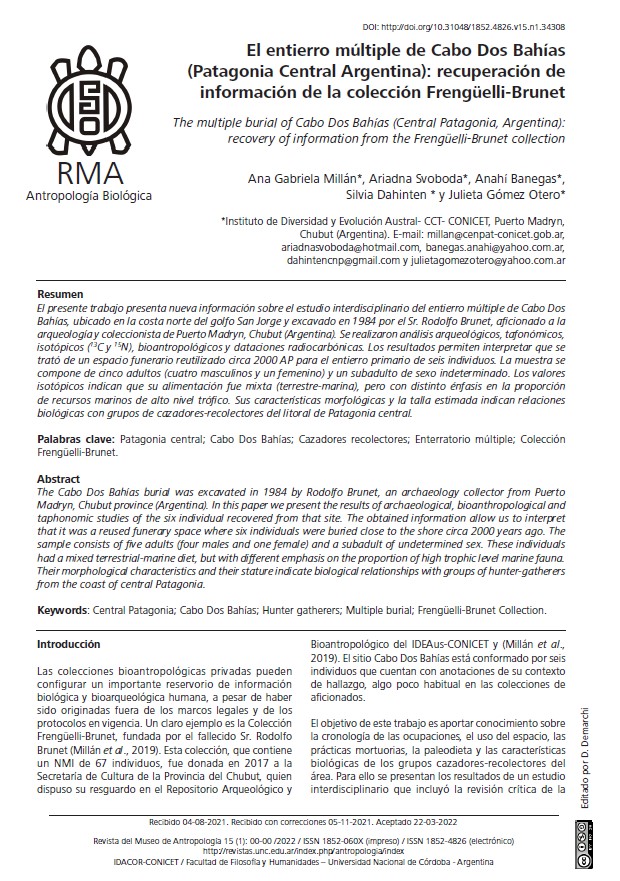The multiple burial of Cabo Dos Bahías (Central Patagonia, Argentina): recovery of information from the Frengüelli-Brunet collection
DOI:
https://doi.org/10.31048/1852.4826.v15.n1.34308Keywords:
Central Patagonia, Cabo Dos Bahías, Hunter gatherers, Multiple burial, Frengüelli-Brunet CollectionAbstract
The Cabo Dos Bahías burial was excavated in 1984 by Rodolfo Brunet, an archaeology collector from Puerto Madryn, Chubut province (Argentina). In this paper we present the results of archaeological, bioanthropological and taphonomic studies of the six individual recovered from that site. The obtained information allow us to interpret that it was a reused funerary space where six individuals were buried close to the shore circa 2000 years ago. The sample consists of five adults (four males and one female) and a subadult of undetermined sex. These individuals had a mixed terrestrial-marine diet, but with different emphasis on the proportion of high trophic level marine fauna. Their morphological characteristics and their stature indicate biological relationships with groups of hunter-gatherers from the coast of central Patagonia.
Downloads
References
Aranda, C. & Del Papa, M. (2009). Avances en las prácticas de conservación y manejo de restos humanos en argentina. Revista Argentina de Antropología Biológica, 11(1), 89-93.
Aranda, C., Zuccala, K., Avido, D., Salvarredy, A., Luna, L. & Gigliotti, V. (2010). Manejo de colecciones osteológicas del museo etnográfico J.B. Ambrosetti (FFyL, UBA). Recuperado de http://www.researchgate.net/publication/256458348.
Bass, W. (1995). Human Osteology: A Laboratory and field Manual of the human Skeleton. (3d ed.) Columbia: Missouri. Archaeological Society.
Béguelin, M. & González, P. N. (2008). Estimación del sexo en poblaciones del sur de Sudamérica mediante funciones discriminantes para el fémur. Revista Argentina de Antropología Biológica, 10(2), 55-70.
Behrensmeyer, K. (1978). Taphonomic and Ecologic Information from Bone Weathering. Paleobiology, 4(2), 150-162.
Buikstra, J. E. & D. H. Ubelaker. (1994). Standards. For data collection from human skeletal remains. Arkansas Archeological Survey Research Series N° 44. Arkansas.
Campillo, D. & Subirá, M. E. (2004). Antropología física para arqueólogos. Ariel Prehistoria, Barcelona.
Gómez Otero, J. (2007). Isótopos estables, dieta y uso del espacio en la Costa Atlántica Centro-septentrional y el Valle inferior del Rio Chubut (Patagonia Argentina). En F. Morello, M. Martinic, A. Prieto y G. Bahamondes (Eds.), Arqueología de Fuego-Patagonia. Levantando piedras, desenterrando huesos…y develando arcanos (pp. 151-162). CEQUA, Punta Arenas.
Gómez Otero, J. & Dahinten, S. L. (1997/98). Costumbres funerarias y esqueletos humanos: variabilidad y poblamiento en la costa nordeste de la provincia del Chubut. Relaciones de la Sociedad Argentina de Antropología, XXII-XXIII, 101-124.
Guarido, A. L. (2020). Procesos de formación en los entierros humanos de Río Bote 1 (Santa Cruz, Argentina). La Zaranda de Ideas Revista de Jóvenes Investigadores 18(1), 26-42.
Gutiérrez, M. A. (2004). Análisis Tafonómicos en el Área Interserrana (Provincia de Buenos Aires), Repositorio Institucional de la Universidad Nacional de La Plata, Argentina. https://sedici.unlp.edu.ar/handle/10915/4574
Hogg, A., Heaton, T., Hua, Q., Palmer, J., Turney, C., Southon, J., Bayliss, A., Blackwell, P., Boswijk, G., Ramsey, C., Pearson, C., Petchey, F., Reimer, P., Reimer, R. & Wacker, L. (2020). SHCal20 Southern Hemisphere Calibration, 0–55,000 Years cal BP. Radiocarbo 62(4), 759-778.
Lyman, L. R. (1994). Vertebrate Taphonomy. Nueva York: Cambridge University Press.
Mengoni Goñalons, G. (1999). Cazadores de guanacos en la estepa patagónica. Buenos Aires: Sociedad Argentina de Antropología.
Millán, A. G. & Dahinten, S. (2019). La Colección Bioantropológica del norte de Chubut (Secretaría de Cultura de Chubut / IDEAUS-CONICET): Integración, conservación e investigación. En J. Gómez otero, A. Svoboda y A. Banegas (Eds), Arqueología de la Patagonia: El pasado en las arenas (pp. 205-213) , IDEAus-CONICET, Puerto Madryn.
Millán, A. G., Gómez Otero, J. & Dahinten, S. (2013). Tendencia secular de la estatura en poblaciones humanas del valle inferior del rio Chubut y de la costa centro-septentrional (Patagonia Argentina) durante el holoceno tardío. Relaciones de la Sociedad Argentina de Antropología, XXXVIII (2), 421-440.
Millán, A. G., Mohamed, N & Dahinten, S. (2019). Recuperación, curación y estudios bioantropológicos de la Colección Frengüelli-Brunet. Revista del Museo de Antropología, 12 (3), 73-80.
Millán, A. G, Tamburrini, C., Parolín, M. L., Dahinten, S., Gómez Otero, J. & Suby, J. (2021). Estimación sexual en restos óseos de cazadores-recolectores de Patagonia Central Argentina: contrastación de métodos morfométricos con análisis paleogenéticos. Revista Argentina de Antropología Biológica 23 (2).
Moreno, E., Zangrando, A. F., Tessone, A., Castro, A. S. & Panarello, H. (2011). Isótopos estables, fauna y tecnología en el estudio de los cazadores-recolectores de la costa norte de Santa Cruz. Magallania, 39/1, 265-276.
Scheuer, L. &. Black, S. (2000). Developmental Juvenile Osteology. Elsevier Academic Press. California
Trotter, M. & Gleser, G.C. (1958). A re-evaluation of estimation of stature based on measurements of stature taken during life and long bones after death. American Journal of Physical Anthropology, 16, 79-123
Zilio, L., Tessone, A. & Hammond, H. (2018). Stable isotope ecology and human palaeodiet in the northern coast of Santa Cruz (Argentine Patagonia). International Journal of Osteoarchaeology, 1–13.

Downloads
Published
Issue
Section
License
Copyright (c) 2022 Ana Gabriela Millán, Ariadna Svoboda, Anahi Banegas, Silvia Dahinten, Julieta Gómez Otero

This work is licensed under a Creative Commons Attribution-NonCommercial-ShareAlike 4.0 International License.
Those authors who have publications with this Journalaccept the following terms:
a. Authors will retain their copyrights and guarantee the journal the right of first publication of their work, which will be simultaneously subject to the Creative Commons Attribution License (Licencia de reconocimiento de Creative Commons) that allows third parties to share the work as long as its author and his first publication in this journal.
b. Authors may adopt other non-exclusive licensing agreements for the distribution of the version of the published work (eg, deposit it in an institutional electronic file or publish it in a monographic volume) provided that the initial publication in this journal is indicated.
c. Authors are allowed and recommended to disseminate their work on the Internet (eg in institutional telematic archives or on their website) before and during the submission process, which can lead to interesting exchanges and increase citations of the published work. (See The Effect of Open Access - El efecto del acceso abierto)











